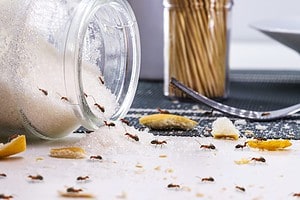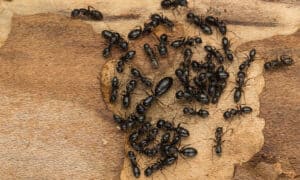With summer getting closer, it is time to prepare for Wisconsin’s summer residents to emerge. Each year, several different ant types come out to enjoy summer in the warm and humid Wisconsin weather. These may be a pest in the yard, but they are even more problematic when they make their way indoors. As you get ready for fun in the sun this summer, it is also time to get ready to manage the ants in Wisconsin as they threaten to make their way indoors.

Ants in Wisconsin
The United States is home to over 1,000 different ant species. In Wisconsin alone, at least 76 different ant species have been caught on film. Many of these ants have migrated from other parts of the country or even from other parts of the world. However, most of the ants you see in Wisconsin are from just a common ant species.
As the temperatures warm up and there are more food sources available, ants become active in Wisconsin. You can expect to see various ant species become active in this part of North America beginning in late spring until early fall. However, a few of the species named on this list may remain active all winter long if they get the chance to establish nests indoors. Let’s learn together now about the world of ant types in Wisconsin. Each of these will start to emerge during the spring by April or May and will stick around until early fall. However, a few may remain active if they make their way inside.
1. Ants in Wisconsin: Pavement Ant (Tetramorium immigrans)
The pavement ant originated in Europe but came to the United States hundreds of years ago. Today, pavement ants live across all 50 states, including Wisconsin. These ants become household pests when they enter homes looking for food. Pavement ants range in size from as small as 1/16th to ⅛ of an inch. Their small stingers might cause some mild irritation for humans, but their stings are generally harmless. You can expect to see pavement ants in Wisconsin emerge during the spring. They establish new colonies and mate during the summer. However, pavement ants can survive indoors and stay active if they establish nests in safe, warm places that can survive the winter.
Pavement ants have two nodes on their petiole, grooves on the head and thorax, and spines on their backs. They gained their nickname of “pavement ants” due to the mounds they build outside on sidewalks or on pavement. Typically, you can find pavement ant nests in soil under or next to sidewalks, driveways, patios, or other places with slabs of concrete or other types of pavement. You may be able to identify them when they leave behind dirt inside. They will eat almost anything and might come inside your house searching for honeydew, the sugary substance made by aphids and other insects. However, they also consume seeds, other insects, cheese or other fatty foods, and a wide variety of sugary foods.
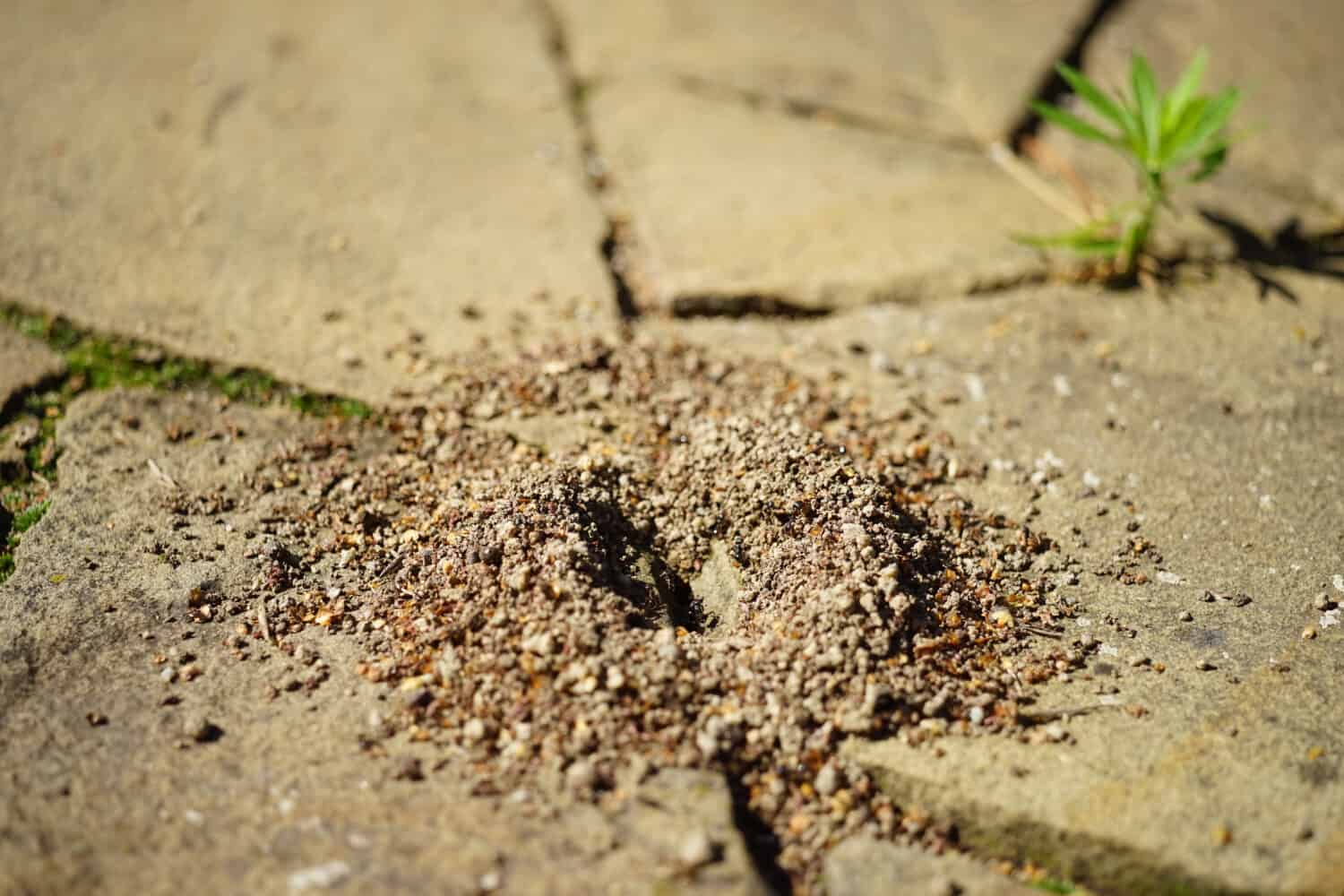
Pavement
ants build
nests on sidewalks and near driveways.
©newsony/Shutterstock.com
2. Ants in Wisconsin: Thief Ants (Solenopsis molesta)
As we head into summer, another species of ant in Wisconsin will soon emerge: the thief ant. Also known as “grease ants,” thief ants are tiny – they measure only about 1/16 of an inch in length. Their bodies are light yellow or brown in color.
Thief ants like to build their nests in close proximity to other ant colonies. This is partly because thief ants are known for eating the larvae of other ant species. They regularly invade other ant species’ nests to “steal” the larvae and pupae to eat. This inspired the name “thief ant.” Thief ants will build colonies indoors or outside under rocks or in the soil. As an adaptable species, thief ants prefer to eat protein-rich foods and will scavenge other insects when ant larvae are not available.
Thief ants become pests in Wisconsin when they move inside to search for food. Because they establish multiple nests, with “satellite” nests for the same colony, thief ants can also be difficult to eliminate. Thief ants are known as late summer ants. They mate sometime between July and September. This season is when you may start to notice thief ants around your home, as they enter houses from their outside nests.

Thief ants build their nests near those of other ant species so they can easily steal other species’ larvae to eat.
©Mathisa/Shutterstock.com
3. Ants in Wisconsin: Field Ants (Formica)
Field ants are a diverse group of ants that live in Wisconsin and are known for being aggressive and assertively defending their large colonies. They are typically black or red in color and grow to be on the larger side, between ¼ of an inch to ½ of an inch long.
Field ants gained their name for their habitat. These ants typically build nests in open fields, meadows, grasslands, and park areas. They construct large mounds that can be as large as several feet across. Field ants build their nests outside during the spring and early summer and are very common, particularly in southeastern Wisconsin. If you find yourself outdoors in Wisconsin around April or May, you may start to see field ant nests outdoors on lawns, near sidewalks, beside trees, or under logs.
As a territorial species, field ants will defend their colonies vigorously. Their strong bodies include large stingers, and though their stings are not as painful as those of a fire ant, they do have strong bites. Field ants also have the ability to release formic acid, which can produce a burning feeling on human skin. Field ants will eat a wide range of foods, though they prefer to eat honeydew or scavenge to eat other insects.

Field ant species build their nests in fields and pastures.
©Nataly Studio/Shutterstock.com
4. Ants in Wisconsin: Odorous House Ants (Tapinoma sessile)
Among the most interesting ants in Wisconsin is the odorous house ant. This species is commonly found in Wisconsin as well as in other parts of North America. These small ants typically range from 1/16 to ⅛ of an inch in length and come in shades of dark brown or black. A distinctive characteristic of odorous house ants is that when they are crushed, they smell like rotten coconut. They gained their nickname in honor of this pungent odor.
Odorous house ants are extremely adaptable and live in a broad range of environments. You may find them in soil, under rocks, or in wood. When they come indoors, it may be to build a nest inside your house’s walls, under the floor, or near moist areas such as around pipes. Odorous house ants are a very social species that live in large colonies. As summer approaches, they become more active. Typically, you may see the first odorous house ants of the season between May and July. However, if they build a nest inside your home, they can be active all year long.
Odorous house ants eat diverse diets, including sugar, honeydew, and ripe fruit, as well as dead insects and fatty material. They may become a nuisance when they come into your home searching for these foods or in search of water. Though they do not cause damage by chewing wood or other material, having their nests inside your home may become bothersome.
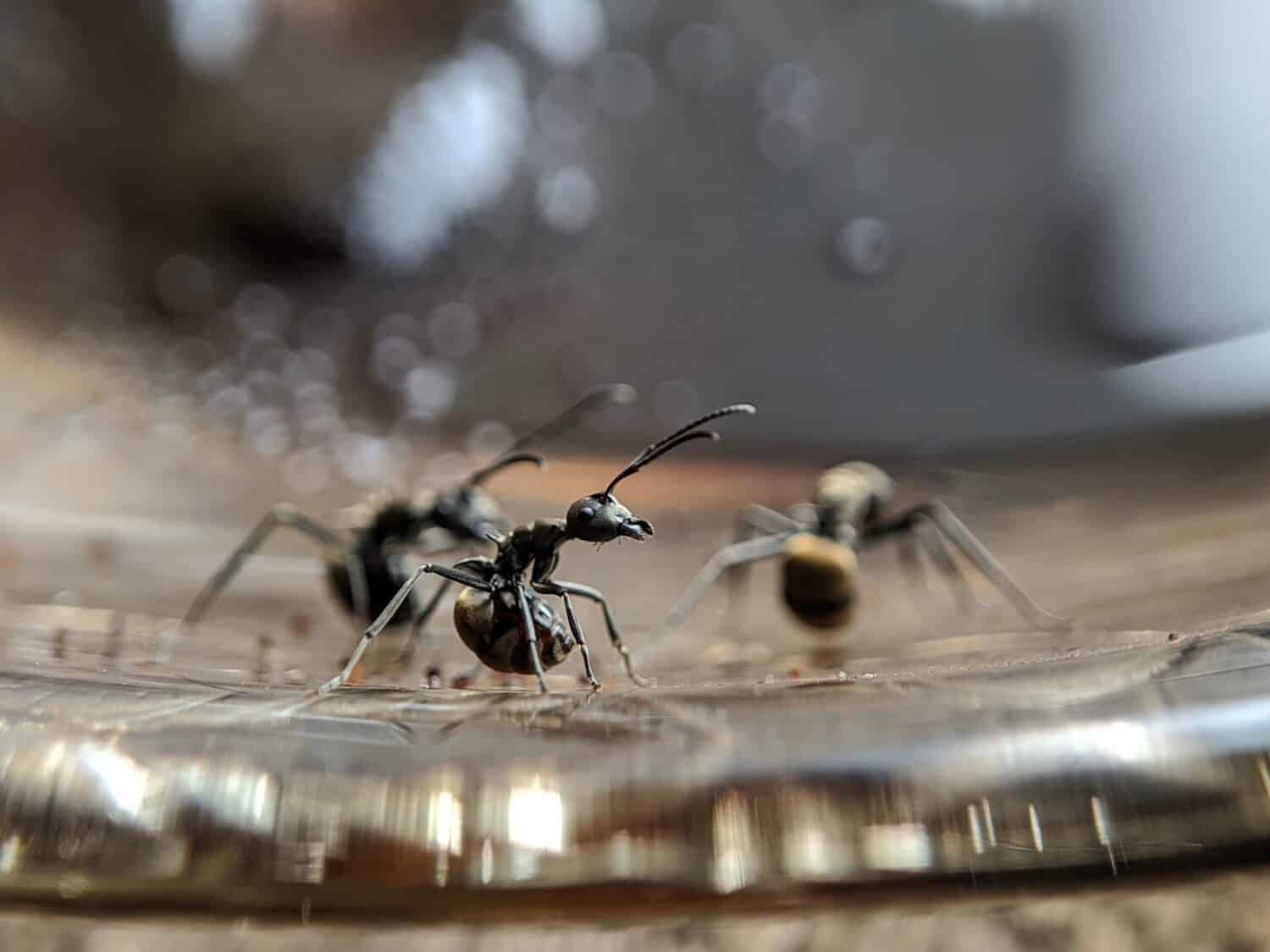
Odorous house ants in Wisconsin emit a unique scent that smells like rotten coconut.
©Dhe Tong/Shutterstock.com
5. Ants in Wisconsin: Black Carpenter Ant (Camponotus pennsylvanicus)
Another prevalent type of ant in Wisconsin is the black carpenter ant. Carpenter ants are large ants that make their home in moist wood. Carpenter ants live across the world, and there are many different species of carpenter ants alive. In the United States and parts of Canada, one of the most common is the black carpenter ant. This was the first North American ant species named. In Wisconsin, black carpenter ants are one of the most prevalent species of ants. They are drawn to wood, particularly that of moist, decaying trees, stumps, or branches. Because of this, they often inhabit woodland areas or forested residential areas. However, though carpenter ants chew wood, they are different from termites.
Black carpenter ants live in colonies together with other worker ants and one queen, who is bigger than the others. They make nests by chewing on wood to build homes for the colony – which is fine in the forest, but annoying when the wood they chew is part of a house or other building! Carpenter ants are large and can be as big as ½ of an inch long. They eat protein-rich foods in the springtime, particularly other insects. In the summer, they like carbohydrate-rich foods such as honeydew. Carpenter ants in Wisconsin come out each year in the spring. However, this can range from April to June depending on when the weather starts to warm up.
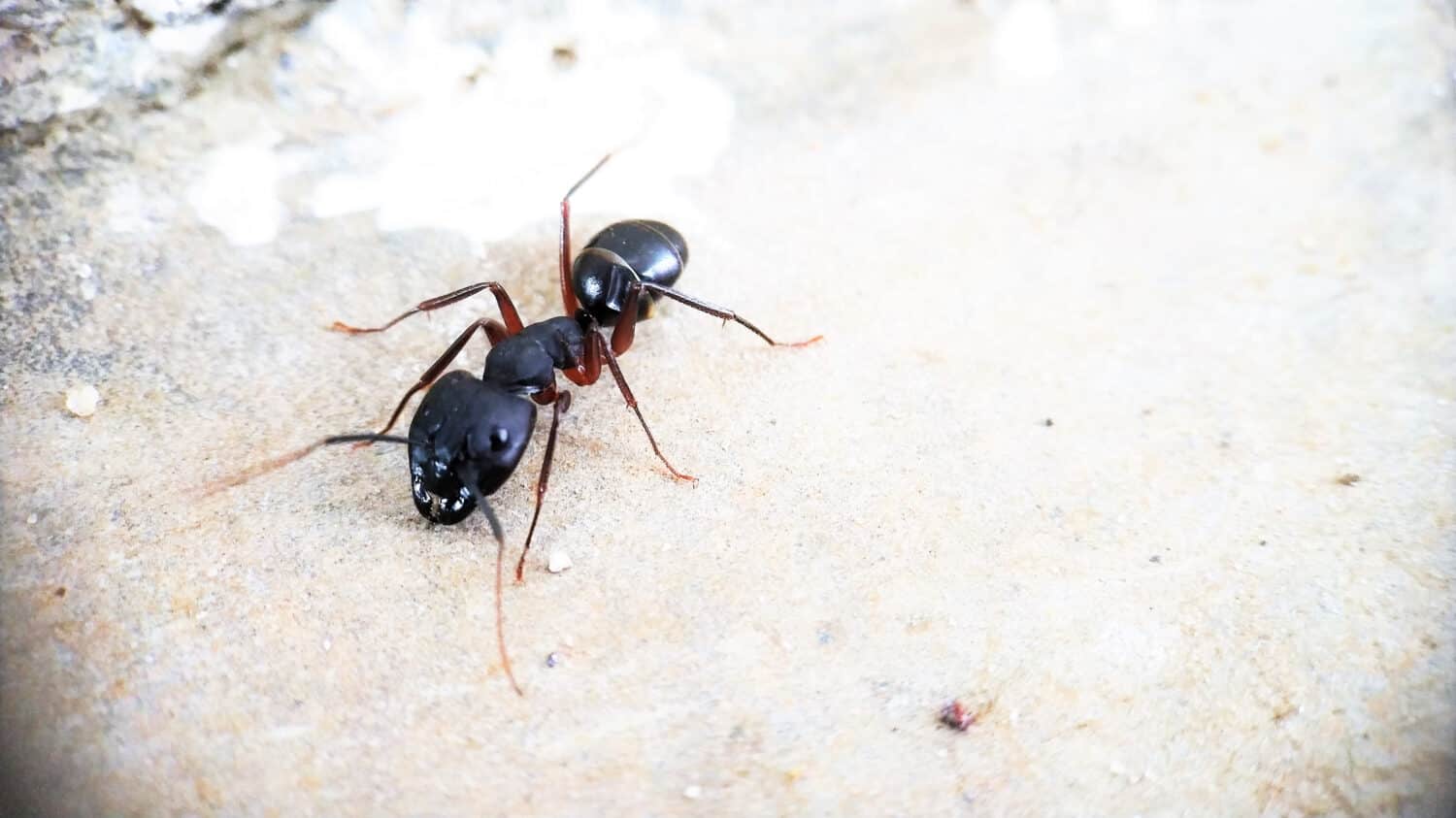
Black carpenter ants live in wooded areas, which can attract them to homes built using lumber. Image: IamBijayaKumar, Shutterstock
©IamBijayaKumar/Shutterstock.com
Other Insects Set to Emerge in Addition to Ants in Wisconsin
Ants aren’t the only insects excitedly waiting to emerge during the summer. Wisconsin has a diverse insect population that becomes active during the spring and summer months. As the weather heats up, here are a few other insect pests you can plan to see in Wisconsin each summer in addition to the five ant types in Wisconsin.
Mosquitoes
Mosquitoes may be one of the most annoying insects in Wisconsin and throughout the United States. These biting insects thrive in places with puddles and other standing water and are extremely prevalent during Wisconsin summer. They are particularly active around dawn and dusk. There are several types of mosquitoes found in Wisconsin, including the northern house mosquito (Culex pipiens), the eastern tree hole mosquito (Aedes triseriatus), and the common floodwater mosquito (Aedes vexans).
Mosquitoes go through four life stages, from egg to larva to pupa and, finally, adult. They lay their eggs in or near water, where the eggs then hatch into larvae. As larvae feed, they develop into pupae before eventually becoming adult mosquitoes. At that point, male mosquitoes feed primarily on plant nectar. However, female mosquitoes require blood to provide the nutrients for them to develop eggs. As a result, they bite and suck the blood of humans, birds, and mammals. This makes them a pest that can also carry disease and cause unpleasant itching for the humans and animals they bite. To reduce mosquito bites during the summer, use insect repellant, wear long sleeves, and use window screens to keep them outside.
Ticks
Ticks are a significant concern in Wisconsin and neighboring states, where they inhabit forests and grassy areas. Several species of ticks live in Wisconsin. These include the black-legged tick (Ixodes scapularis), the American dog tick (Dermacentor variabilis), and the wood tick (Dermacentor andersoni). These ticks usually live in humid, shady areas such as those of tall grass meadows and woodlands. Because ticks are ectoparasites, they attach to mammals to feed on their blood. This can be dangerous for humans since ticks can transmit diseases such as Lyme disease to the humans they bite.
Bees and Wasps
Bees and wasps play an important role in Wisconsin, particularly through the pollination of many native plants. However, these insects can be pests when they invade outdoor spaces such as lawns and patios and threaten to sting aggressively. Some of the common bees and wasps in Wisconsin include honeybees (Apis mellifera), bumblebees (Bombus species), mason bees (Osmia species), yellow jackets (Vespula species), paper wasps (Polistes species), mud daubers (Sceliphron species), hornets (Vespa species), and others.
Summary of 5 Ant Types Are Set to Emerge This Summer in Wisconsin
| Ants | Fun Fact | |
|---|---|---|
| 1 | Pavement Ant | Got their name from the tendency to build mounds on roads and sidewalks |
| 2 | Thief Ants | They steal and eat larvae from other ant species |
| 3 | Field Ants | Field ants defend their large mounds aggressively with mildly painful bites |
| 4 | Odorous House Ants | They smell like rotten coconut when they are crushed |
| 5 | Black Carpenter Ant | Carpenter ants build their nests from chewed wood |
The photo featured at the top of this post is © Pedro Bernardo/Shutterstock.com
Thank you for reading! Have some feedback for us? Contact the AZ Animals editorial team.



